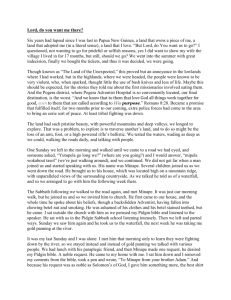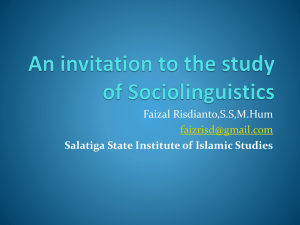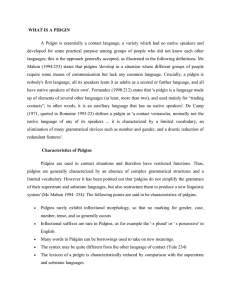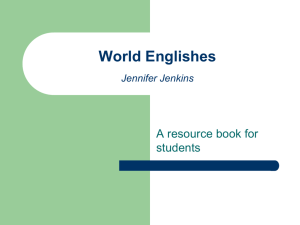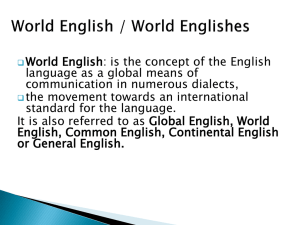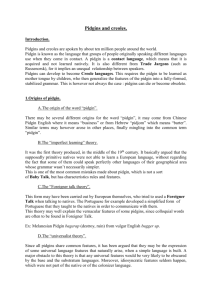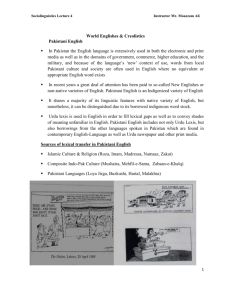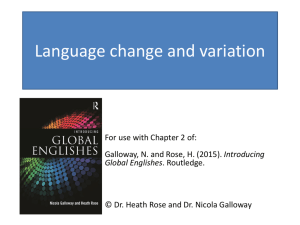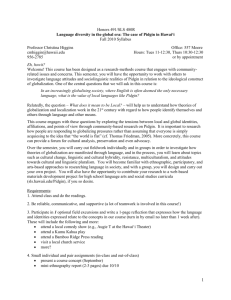Sociolinguistics: Linguistic Varieties & Multilingual Nations
advertisement
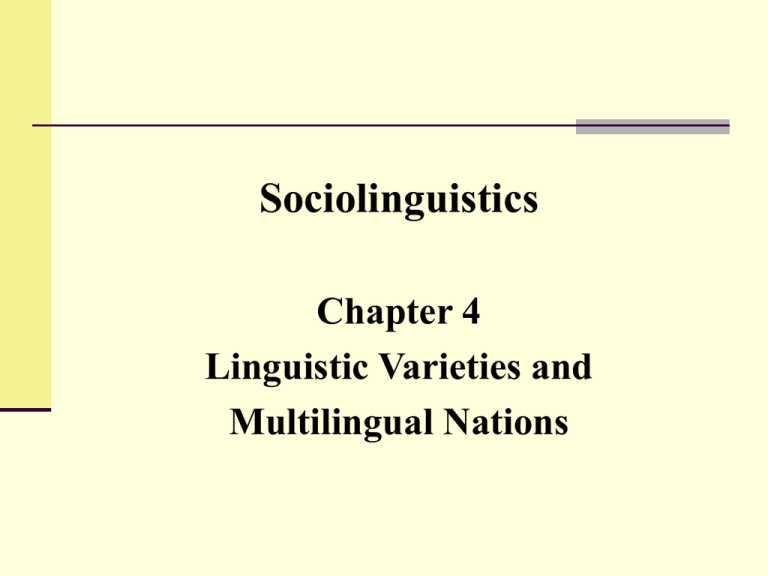
Sociolinguistics Chapter 4 Linguistic Varieties and Multilingual Nations Learning Objectives Vernacular languages Standard languages World Englishes Lingua francas Pidgins and creoles Vernacular A language which has not been standardised and does not have official status. Vernacular Three components: 1. It is an uncodified or unstandardised variety 2. It is acquired at home as a first variety. 3. It is used for relatively circumscribed functions. Exercise 1 Standard language A standard variety is one: which is written and has gone some degree of regularisation or codification which is recognised as a prestigious variety which is used for H functions World Englishes The term World Englishes is used to emphasise the range of different varieties of English that have developed since the nineteenth century. Kachru’s Three Concentric Circles The Expanding Circle China, Egypt, Indonesia, Israel, Japan, Korea, Nepal, Saudi Arabia, Taiwan, Russia, Zimbabwe, South Africa, Caribbean Islands (EFL) The Outer Circle Bangladesh, India Ghana, Kenya, Nigeria, Malaysia, Pakistan, Philippines, Singapore, Sri Lanka, Tanzania, Zambia (ESL) The Inner Circle USA UK Canada Australia New Zealand 5 phases of World English Phase 1 Foundation and consolidation English becomes generally dominant, a standard form evolving with the arrival of the printing press and the spread of organised education. 5 phases of World English Phase 2 The adventurers English-speaking settlers emigrate to North America (the United States and Canada), Australia and New Zealand, where they establish English-speaking colonies. 5 phases of World English Phase 3 The independent colonies Beginning with the breakaway of the Thirteen Colonies in America, the phase covers the increasing emancipation from the mother country of Australia, New Zealand, Canada, and so forth. 5 phases of World English Phase 4 The colonial subjects English is deliberately taught, especially from about 1925 onward, to colonial peoples through English-medium education systems in Africa, South Asia, East Asia, the Pacific and elsewhere. 5 phases of World English Phase 5 Cultural independence In previous phases, the centre of gravity of English had been culturally ‘nativist’ and in the Phase 4 had been taught paternalistically, ‘embedded’ in the matrix of English (or America) social and cultural ideas. 5 phases of World English Example: School textbooks in English fixated on the behaviour and attitudes of a mythical Mr. and Mrs. Smith, their son John, their daughter Mary, and their dog Spot. 5 phases of World English In Phase 5, the nativist approach was increasingly dismissed and disdained, as various countries developed English ‘for national unity, for international communication, as a window on world events.’ McArthur’s Circle of World English The Circle of World English Highlights the broad three-part spectrum that ranges from the ‘innumerable’ popular Englishes through the various national and regional standards to the remarkably homogenous but negotiable ‘common core’ of World Standard English. Activity 4.1 1. Does English English make sense? 2. Is it likely that a uniform standard will emerge for English in East Asia? 3. Is Canadian English sufficiently distinct from American English to merit a separate section? 4. Can’t the English of Scotland be separated out as having its own national standard? 5. Isn’t Tok Pisin an entirely different language? Nativised variety of English – The case of Singapore English The local aspirations and identities are reflected in linguistics characteristics such as: stress patterns grammatical features which reflect the influence of local languages vocabulary from local languages Activity 4.2 Watch a clip from the Singapore film production ‘I Not Stupid’小孩不笨, and identify features of Colloquial Singapore English. Lingua franca A language serving as a regular means of communication between different linguistic groups in a multilingual speech community. Pidgins and creoles Pidgins develop as a means of communication between people who do not have a common language. A pidgin is no one’s native language. Pidgins and creoles A pidgin language has three identifying characteristics: 1. It is used in restricted domains and functions 2. It has a simplified structure 3. It generally has low prestige Exercise 5 Pidgins and creoles A creole is a pidgin which has acquired native speakers. Exercise 7 Case study – Chinese Pidgin English Chinese Pidgin English is one of the oldest varieties of English-lexicon pidgin. Activity 4.3 Watch the video and answer the questions. Case study – Chinese Pidgin English Phonology Avoidance of difficult sounds (e.g. consonant clusters) Simple syllable structure (CV) Case study – Chinese Pidgin English Phonology 1. Consonant clusters broken up by the insertion of vowels 2. Clusters are simplified by losing one of the consonants Case study – Chinese Pidgin English Semantics Maximum use of a minimum lexicon Extension of meanings Case study – Chinese Pidgin English Tense The context alone indicates tense. Adverbials like before, day after tomorrow provide necessary clues. Case study – Chinese Pidgin English Negation The negator is always a separate word and invariant in form. It occurs before the verb. This may be because of a universal preference among languages with SVO word order for preverbal modification. Case study – Chinese Pidgin English Use of classifier Wun One 一 NUM piece piece 個 Cl wifoo wife 妻子 NOUN
